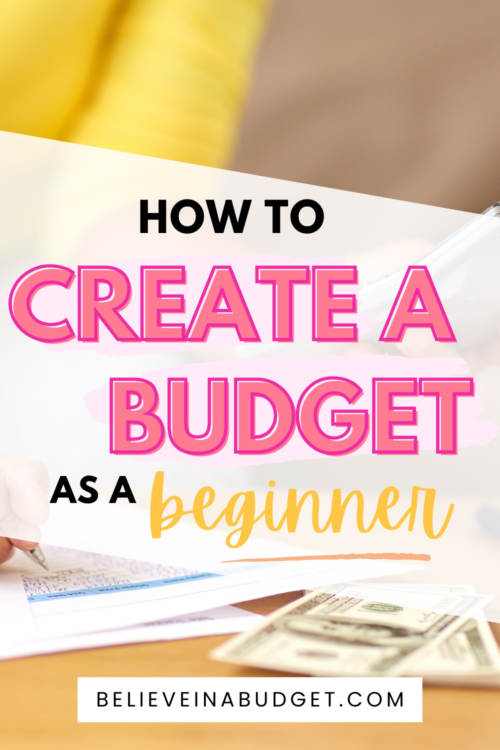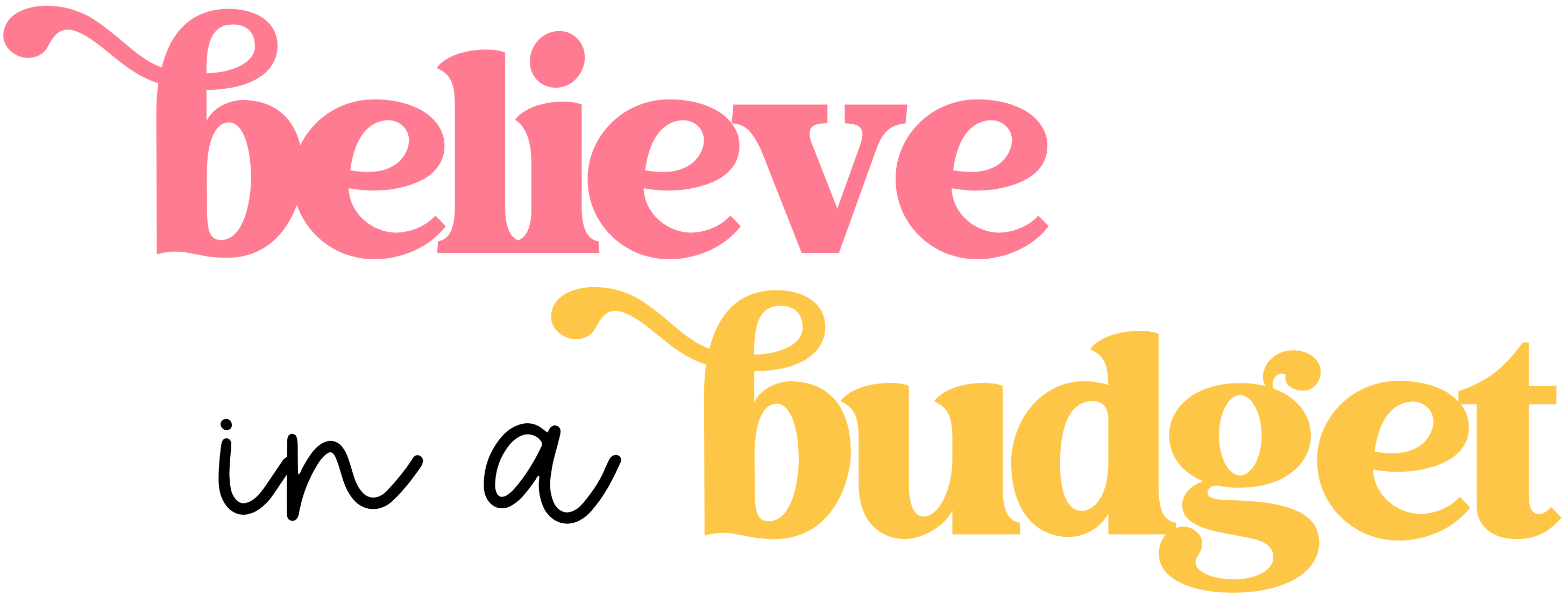How to Create a Budget as a Beginner
Are you ready to create a budget and save money? You are not alone!
It is never too late to start a budget at any age or time.
According to CNBC, 70% of Americans feel financially stressed, with fewer than 50% of U.S. adults having an adequate emergency fund. Let’s avoid this stress by creating a budget!
As a budget beginner, sticking to a simple plan is essential. The following five steps will help you be more financially responsible and meet your goals for the new year.
Step 1: Set personalized goals
Before you get the calculator out, take a few moments to jot down a few personal financial goals. There is a reason you are learning how to create a budget.
You may need help with credit card debt, want to purchase your first home, or suddenly have less income due to student loan payments or a new car.
The entire reason I started Believe In A Budget was to share how I wanted to pay off my credit card debt while side hustling, so I understand what it’s like to set a budget and create goals!
I like to use a notebook to keep track of all my goals and personal notes, but you can also use the notes app on your phone.
It’s smart to set goals to plan for a vacation, a shopping trip or even going out to eat.
Whatever your situation, you can easily create a budget that works for you.
Having financial goals not only helps you pay off your debt faster but can also give you insight into your overall spending habits.
Step 2: Calculate your net income
If you are a salary worker or generally have the same pay weekly, bimonthly (every two weeks), or monthly, it will be easy to calculate your monthly income.
Use your take-home pay, the amount you receive in your check or deposited in your bank account, to calculate your monthly net income.
Part-time workers, employees with variable hours, or gig workers may calculate an average take-home pay.
When I used to side hustle in addition to my full time job, I always made sure to track my side hustle income separately!
Gather as many pay statements as possible, add up all of them, and divide them by how many months of pay you have collected.
If your side hustle gig doesn’t provide you with a traditional paycheck, keep track of how much you are paid per gig.
This calculation will give you an average monthly income.
Creating a budget that reflects your lowest monthly pay is best if your income varies widely.
Remember, as a 1099 employee, you must deduct 15.3% from your monthly take-home pay for taxes.
Step 3: Track your expenses
The top expenses are housing, transportation, food, and insurance. However, it’s critical to track every personal expense when learning how to budget as a beginner.
Remember to add student loan payments, entertainment, apparel and charity.
I also include categories for my pets, including monthly medication, food and trips to the vet.
If you have help, such as lawn care or a house cleaner, make sure to add this to your monthly expenses as well.
I also like to include health, beauty and skin care, so create line items if you have fitness expenses or invest in any skin care treatments.
To be safe, you can even add a a miscellaneous category to track where your hard-earned money is going accurately.
I have found that by tracking my monthly expenses, I am able to review my budget throughout the year and know what to expect for the upcoming month simply by looking at past expenses.
Housing
Take a look at your housing costs. It would help if you only spent 30% or less of your gross monthly income (before taxes and deductions).
- Renters: 30% includes rent, heat, water, and electricity
- Homeowners: 30% includes mortgage, interest, insurance, property taxes, and utilities
With rising inflation, evaluating housing costs is vital, which is most likely your most significant expense.
If you are spending more than 30%, look at your options.
Is it better to stay or move? Can you reduce expenses in other areas to compensate for rising housing costs?
However, if you have minimal expenses in other areas of your budget, sometimes you can justify paying more with housing.
Moving can be costly, especially when factoring in additional expenses like rental deposits, moving help and setting up or transferring utilities.
Transportation
Transportation costs include car payment(s), insurance, and fuel and should be at most 10% of your monthly income.
With the average new car approaching $50,000 and a used car at $26,000, monthly loan payments alone can be significant.
J.D. Power recommends using the 20/4/10 rule, which means having at least 20% of the car purchase price saved for a down payment.
You should also keep your loan term to four years, and keeping transportation costs to just under 10% of your monthly income.
If you cannot do this, opt for a longer loan and try to make additional principal payments.
When we have financed vehicles in the past, we will shop for the best rate, even if the term is longer.
We are only comfortable doing this because we have a plan in place to make additional principal payments which have significantly shortened our payment loan. Again, only do this if you feel like this is in your budget.
In the past, we have typically purchased a new car and driven it for as long as possible. My last car was twelve years old before it no longer felt safe to drive.
While the expense was larger up front, it was nice not to have a car payment for several years.
When it comes to your vehicle, this can be quite a personal choice. As always, look at your budget to determine how much you feel comfortable spending on a car payment.
If you choose to finance your vehicle, shop around for the best interest rate. When we financed one of our vehicles, we were able to find a great loan through a credit union as opposed through the dealership.
If you live in a public transportation-friendly city, consider using public transit, biking, or walking to commute to work or run errands.
Doing so could significantly reduce transportation costs and, in some cases, even the need for a vehicle and insurance!
Food
Many of us agree that food can be one of our biggest monthly expenses in our budgets. From dining out, delivery service or even wasting groceries, this can be the hardest item to budget!
The younger Gen X generation (ages 35-44) spends the most on groceries, averaging over $14 daily. That means the average 35-44-year-old spends over $400 per person monthly on food.
Cutting your food budget is one of the easiest ways to put more cash back in your pocket. You don’t have to spend much money to eat well; it just takes some planning.
Download grocery apps to look for savings, coupons and buy one, get one free deals.
As on Amazon Prime member, you can receive additional savings at Whole Foods when using the app at checkout.
I personally take advantage of Whole Foods pickup and delivery service for many of our groceries as there 365 brand is affordable and healthy.
With Target’s Circle app, there are often deals such as spend $50 on groceries or household items and receive a $15 Target gift card back.
Post shopping, don’t forget to use Ibotta to scan your receipt to earn cash back via PayPal.
Fetch is another great post-purchase app to use to earn points towards gift cards. You simply scan your receipt and can redeem your points for gift cards ranging from $10 – $50.
Related reading:
- 7 Ways to Save $500 Right Now
- Breaking Down My $50 Grocery Budget
- How to Save Money on Groceries Without Coupons
Insurance
Whether you pay for health, car, or home insurance (or all three!), the monthly costs can add up.
While the final cost can be attributed to pre-existing conditions, vehicle collisions, and home policy claims, there are ways to keep your insurance premiums in check.
Once a year before your policy expires, ask customer service if the premium will stay the same or increase.
If the premium is increasing, tell them about your budgetary concerns and ask if there are ways to keep costs down. You may qualify for a new discount or bundle promotion.
When possible, try to bundle your insurance for a reduced rate.
If your premiums continue to increase, consider switching insurance companies.
Use an online rate comparison tool or talk with an independent agent who works for multiple insurance companies to ensure you get the best deal.
Due to rising costs these past few years, I have personally chosen to work with an independent agent to help find the best insurance rate at no additional cost.
Typically, an agent has access to multiple rates and can help find the best price for your insurance needs.
I simply make a note in my calendar to reach out to my agent before the renewal period to shop for rates again.
This is very important because I typically save a significant amount of money by shopping around.
Unfortunately, I have not found that being loyal to one specific company pays off anymore, so I am happy to switch insurance companies to maximize my savings.
Step 4: How to create a budget
It can be daunting when you are first learning how to make a budget as a beginner.
Once you have your income and expenses together, you will start to see where your financial shortfalls are and how to manage money better to reach your goals.
You will get a positive or negative number once you have taken your monthly income and subtracted your expenses.
The total is positive
Congratulations, you are on the right path to financial success!
See if the extra money you have monthly after expenses is enough to meet your financial goals on your timeline.
If it is, continue living your current lifestyle.
Consider putting away extra savings into a high yield savings account to earn interest. We use this account as a way to have an emergency fund and some extra fun money.
Current interest rates are high, meaning your money can earn additional interest without doing anything extra on your end!
If you want more cushion, review your top expenses and see where you could make some cuts.
The total is negative
If you get a negative number, don’t panic.
A negative number means you are spending more than you make, and you will need to tweak your monthly expenses to turn that frown upside down.
Wondering what to cut? Consider cutting costs where most Americans overspend.
These include streaming services, delivery services, credit card interest, gym memberships, unlimited cell phone plans, restaurants, and purchasing impulse items.
Remember that this is where you have plenty of options to side hustle to make extra income!
Related reading:
- How I Made an Extra $4,500 in Side Hustles
- Epic List of Side Hustles
- How to Start a Homemade Dog Bakery and Sell Dog Treats
- How to Make and Sell Printables
Step 5: Review and adjust your budget monthly
It’s vital to review your budget monthly. If you decide to make expense reductions, keep track of that savings.
Is it going into a savings account or paying off debt? Are you spending that money somewhere else?
Take into account if your income increases or decreases. If your expenses change every month, you will need to note that, too.
If you have difficulty being accountable and staying on budget, enlist a friend to help you stay on course.
Plan a date night with your spouse to check in once a month to review expenses and financial goal setting.
Learning to adjust your spending habits can help you take control of your financial future.

Final thoughts when creating a budget as a beginner
As you can see, it’s fairly easy to create a budget each year, even as a beginner! These five simple steps can get you on the right foot in the new year.







